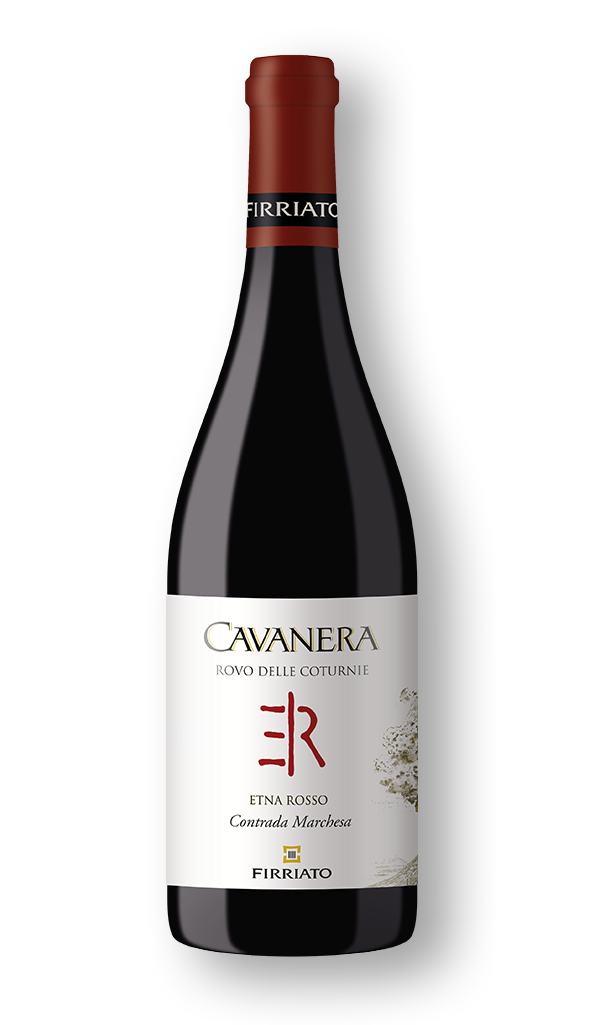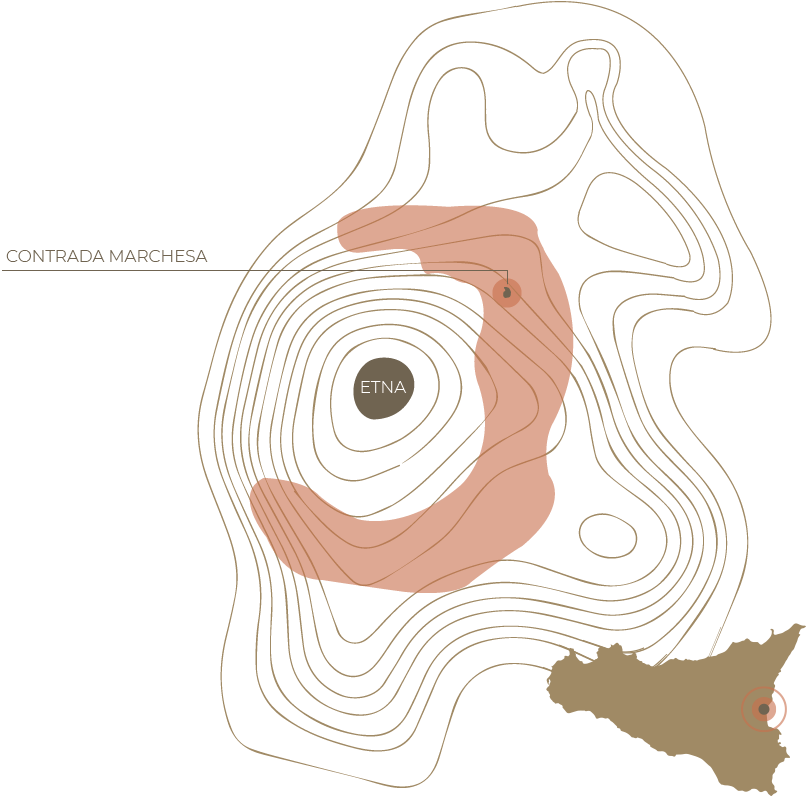
Cavanera Rovo delle Coturnie is one of the most structured and full-bodied expressions that Nerello Mascalese can express, recalling the greatness of the reds of Etna, famous since ancient times. The profile thus markedly characterized, and the valuable body crowned by the elegance of the tannins, find their reasons for being in the selection of the noblest bunches of the Coturnie vineyard, where functionally, early defoliation interventions are carried out during the vintage phase ripening of the grapes, to obtain smaller berries with a thick, pruinous skin that protects the organoleptic properties and aromas contained in the pulp.

Cavanera Rovo delle Coturnie is one of the most structured and full-bodied expressions that Nerello Mascalese can express, recalling the greatness of the reds of Etna, famous since ancient times. The profile thus markedly characterized, and the valuable body crowned by the elegance of the tannins, find their reasons for being in the selection of the noblest bunches of the Coturnie vineyard, where functionally, early defoliation interventions are carried out during the vintage phase ripening of the grapes, to obtain smaller berries with a thick, pruinous skin that protects the organoleptic properties and aromas contained in the pulp.
A district “known” in history for the quality of its red wines, the Verzella area presents different soil and climatic conditions of the vineyards; in fact, the different parcels guarantee wines of high freshness (acid profiles) and aromatic complexity, thanks to this multifaceted microclimatic framework. Shallow, very sandy and fertile soils of volcanic matrix, with high draining capacity, are characterized by the high concentration of nutritional elements such as phosphorus, which determines the concentration of sugars in the must, manganese which increases the defense capacity of the wine from the cold plant, and the iron which contributes to the pigmentation of the black grape varieties, determining the bright color of the native Nerello Mascalese and Nerello Cappuccio grapes. The microclimate of the vineyards is subjected to enormous day/night temperature variations.

Marchesa's districts
688 mt s.l.m.
North - East
In 2020, the harvest in the north-eastern region of the Volcano took place regularly, thanks to a climate which saw temperatures lower than the seasonal average, with the sole exception of the first ten days of August, and abundant rainfall which slightly delayed the of maturation and harvesting. The notable temperature variations, especially during spring, have contributed significantly to guaranteeing a particularly high quality of the grapes, giving the wines intense and complex aromatic profiles. The Nerello Mascalese grapes, harvested during the first week of October, showed a slower ripening process, allowing a notable accumulation of aromatic substances.
In quantitative terms we are in line with the 2015 vintage but on a qualitative level the wines obtained are very aromatic whites with excellent acidity. The Nerello Mascalese revealed brilliant colors, without excess alcohol; the classic method bases have a higher malic acid content than the 2015 vintage. Harvest period for Nerello Mascalese and Nerello Cappuccio: 2nd half of October.
Thanks above all to the altitude, the exposure to the northern winds and the temperature range, there was a slight drop in production, but with an excellent quality of the grapes. The Nerello Mascalese harvest for the rosé took place in the first ten days of October. The wine has a delicate pink color, excellent acidity and an excellent balance between freshness and minerality.
An unforgettable year thanks above all to an almost uniform and very balanced climate with summer temperatures that always remained below the seasonal average, with the absence of heat waves on the eastern side of Sicily. In the Etna area the harvest began at the end of September, a month affected by scattered but not persistent rainfall, and continued until October, characterized, however, by sunny days and a moderately dry climate. The quality of the red grapes was found to be optimal from a phytosanitary point of view thanks to a slow and perfectly balanced maturation of the bunches which suggests elegant reds, with an excellent balance between alcohol, freshness and tannins, therefore destined to last over time.
The vintage appears to be fruitful, both in quantity and above all in quality, "wines with an interesting profile" were obtained. Due to the climate, the harvest lasted until the last week of September. The 2013 vintage allowed a slower harvest and therefore gradual maturation: the harvest was delayed by two weeks. Harvest date: October 20th.
The progress of the vegetative cycle of the vine, during the flowering and fruit set periods, followed a normal course. There were no anomalies during the veraison and ripening phases. The harvest, for the early white varieties, began earlier than the previous campaign. Lucifer, Charon and the other African anticyclones this summer were a godsend for the harvest, "an exceptional year from a quality point of view". This year the heat anticipated its start, the high temperatures also had the merit of improving the quality of the wine we will drink: the heat brings a dehydration effect to the grapes, which causes the water to evaporate, concentrating the acids and sugars, giving life to fragrant wines.
The climatic conditions recorded during the course of the year were quite stable: the winter was characterized by average temperatures and lower rainfall compared to previous years; the rains, however, were abundant in the spring months, preparing the vineyard in the best possible way. The harvest was carried out manually between the second and third ten days of October and recorded a 15% drop in production due to the small size of the bunch but, from a quality point of view, the vintage was excellent.
The climate of the 2010 vintage was characterized by a winter with normal temperatures and little rainfall and a mild spring with little rain. The summer drought risked compromising the well-known perfection of the fruit but the intervention of favorable rainfall at the end of September kept the quality of the grapes high. The pre-harvest period was characterized by cool temperatures, oscillating between 20 and 22°C, and abundant rain, which delayed the start of the harvest due to the slow ripening of the grapes. The harvesting operations of Nerello Mascalese and Nerello Cappuccio began at the beginning of October and were carried out by hand by Etna farmers. The grapes arriving in the cellar were initially destemmed and subjected to fermentation in wooden conical vats. The must, which became wine, was separated from the skins and subjected to malolactic fermentation, to continue a refinement of approximately 10-12 months in Allier oak barrels.
The budding of the plants was delayed compared to previous years due to the favorable climate trend in 2009. The autumn season was characterized by a fairly harsh climate and abundant rainfall, which was also frequent in spring. In this first phase, the growth of the vines slowed down considerably, proceeding regularly in the very hot and humid summer months. The vegetative cycle was constant and allowed for excellent ripening of the fruits, which were harvested manually starting from October 10th.
It was a fairly good year, which began with a climate favorable to the budding of the plant, earlier than annual estimates, and ended with some slowdown in spring due to heavy rainfall, which compromised the growth of the plant while preserving its health. The summer months provided a warm and humid climate, allowing the perfect maturation of the grapes, which were harvested starting from 12 October.
2007 was not an excellent year, due to unstable climatic conditions, with little rainfall in the winter months and abundant rainfall in spring. Production was greatly affected in quantitative terms, estimating a drop of 35% compared to the previous year. Another determining factor in the lack of production of this harvest, which began on 15 October, was the attack of downy mildew during the fruit setting phase. However, the quality of the grapes, and of the wine produced subsequently, was excellent.
In 2020, the harvest in the north-eastern region of the Volcano took place regularly, thanks to a climate which saw temperatures lower than the seasonal average, with the sole exception of the first ten days of August, and abundant rainfall which slightly delayed the of maturation and harvesting. The notable temperature variations, especially during spring, have contributed significantly to guaranteeing a particularly high quality of the grapes, giving the wines intense and complex aromatic profiles. The Nerello Mascalese grapes, harvested during the first week of October, showed a slower ripening process, allowing a notable accumulation of aromatic substances.
In quantitative terms we are in line with the 2015 vintage but on a qualitative level the wines obtained are very aromatic whites with excellent acidity. The Nerello Mascalese revealed brilliant colors, without excess alcohol; the classic method bases have a higher malic acid content than the 2015 vintage. Harvest period for Nerello Mascalese and Nerello Cappuccio: 2nd half of October.
Thanks above all to the altitude, the exposure to the northern winds and the temperature range, there was a slight drop in production, but with an excellent quality of the grapes. The Nerello Mascalese harvest for the rosé took place in the first ten days of October. The wine has a delicate pink color, excellent acidity and an excellent balance between freshness and minerality.
An unforgettable year thanks above all to an almost uniform and very balanced climate with summer temperatures that always remained below the seasonal average, with the absence of heat waves on the eastern side of Sicily. In the Etna area the harvest began at the end of September, a month affected by scattered but not persistent rainfall, and continued until October, characterized, however, by sunny days and a moderately dry climate. The quality of the red grapes was found to be optimal from a phytosanitary point of view thanks to a slow and perfectly balanced maturation of the bunches which suggests elegant reds, with an excellent balance between alcohol, freshness and tannins, therefore destined to last over time.
The vintage appears to be fruitful, both in quantity and above all in quality, "wines with an interesting profile" were obtained. Due to the climate, the harvest lasted until the last week of September. The 2013 vintage allowed a slower harvest and therefore gradual maturation: the harvest was delayed by two weeks. Harvest date: October 20th.
The progress of the vegetative cycle of the vine, during the flowering and fruit set periods, followed a normal course. There were no anomalies during the veraison and ripening phases. The harvest, for the early white varieties, began earlier than the previous campaign. Lucifer, Charon and the other African anticyclones this summer were a godsend for the harvest, "an exceptional year from a quality point of view". This year the heat anticipated its start, the high temperatures also had the merit of improving the quality of the wine we will drink: the heat brings a dehydration effect to the grapes, which causes the water to evaporate, concentrating the acids and sugars, giving life to fragrant wines.
The climatic conditions recorded during the course of the year were quite stable: the winter was characterized by average temperatures and lower rainfall compared to previous years; the rains, however, were abundant in the spring months, preparing the vineyard in the best possible way. The harvest was carried out manually between the second and third ten days of October and recorded a 15% drop in production due to the small size of the bunch but, from a quality point of view, the vintage was excellent.
The climate of the 2010 vintage was characterized by a winter with normal temperatures and little rainfall and a mild spring with little rain. The summer drought risked compromising the well-known perfection of the fruit but the intervention of favorable rainfall at the end of September kept the quality of the grapes high. The pre-harvest period was characterized by cool temperatures, oscillating between 20 and 22°C, and abundant rain, which delayed the start of the harvest due to the slow ripening of the grapes. The harvesting operations of Nerello Mascalese and Nerello Cappuccio began at the beginning of October and were carried out by hand by Etna farmers. The grapes arriving in the cellar were initially destemmed and subjected to fermentation in wooden conical vats. The must, which became wine, was separated from the skins and subjected to malolactic fermentation, to continue a refinement of approximately 10-12 months in Allier oak barrels.
The budding of the plants was delayed compared to previous years due to the favorable climate trend in 2009. The autumn season was characterized by a fairly harsh climate and abundant rainfall, which was also frequent in spring. In this first phase, the growth of the vines slowed down considerably, proceeding regularly in the very hot and humid summer months. The vegetative cycle was constant and allowed for excellent ripening of the fruits, which were harvested manually starting from October 10th.
It was a fairly good year, which began with a climate favorable to the budding of the plant, earlier than annual estimates, and ended with some slowdown in spring due to heavy rainfall, which compromised the growth of the plant while preserving its health. The summer months provided a warm and humid climate, allowing the perfect maturation of the grapes, which were harvested starting from 12 October.
2007 was not an excellent year, due to unstable climatic conditions, with little rainfall in the winter months and abundant rainfall in spring. Production was greatly affected in quantitative terms, estimating a drop of 35% compared to the previous year. Another determining factor in the lack of production of this harvest, which began on 15 October, was the attack of downy mildew during the fruit setting phase. However, the quality of the grapes, and of the wine produced subsequently, was excellent.
Only in the best years is the harvest of selected bunches carried out. Towards the end of October, the bunches are taken to the cellar to undergo the traditional red vinification followed by malolactic fermentation. 12 months of Slavonian wood will refine the aromatic qualities of the Cavanera which will rest in the bottle for a further period of at least 6 months.

Transparent and bright ruby red.

Strong and sophisticated notes of small red fruits, raspberries and peach, which are enveloped by intense nuances of nutmeg and black pepper, framed by more delicate rose petals. A wine that smells of its pleased volcanism in mineral nuances.

The body of the taste and the seduction of the tannins are predominant. Of notable persistence, it expresses its bursting personality in all its components

91 pt

3 viti rosse

91 pt

92 pt


Ogni bottiglia di Signum Aetnae è conservata all’interno di un sofisticato cofanetto in legno serigrafato, uno scrigno che conferisce un tocco di lusso e raffinatezza al pezzo da collezione. Il cofanetto in legno è realizzato con maestria artigianale e rappresenta un elemento distintivo del packaging. La sua superficie è decorata con un motivo serigrafato di alta qualità che richiama l’identità del vino Signum Aetnae e dell’azienda Firriato.
All’interno del cofanetto, la bottiglia di Signum Aetnae è avvolta con cura in una delicata carta velina, che porta il logo del marchio e un sigillo di autenticità. Questo strato di carta protegge la bottiglia durante il trasporto e contribuisce a creare un’esperienza di apertura memorabile.
All’interno della confezione è presente un pieghevole informativo. Il pieghevole contiene dettagliate istruzioni sull’NFT (Non-Fungible Token) associato al vino Signum Aetnae. Spiega come accedere e godere di contenuti digitali esclusivi tramite l’uso dell’NFT, offrendo un’esperienza unica e coinvolgente per gli appassionati del vino.
All’interno del cofanetto, la bottiglia di Signum Aetnae è avvolta con cura in una delicata carta velina, che porta il logo del marchio e un sigillo di autenticità. Questo strato di carta protegge la bottiglia durante il trasporto e contribuisce a creare un’esperienza di apertura memorabile.
All’interno della confezione è presente un pieghevole informativo. Il pieghevole contiene dettagliate istruzioni sull’NFT (Non-Fungible Token) associato al vino Signum Aetnae. Spiega come accedere e godere di contenuti digitali esclusivi tramite l’uso dell’NFT, offrendo un’esperienza unica e coinvolgente per gli appassionati del vino.
All’interno del cofanetto, la bottiglia di Signum Aetnae è avvolta con cura in una delicata carta velina, che porta il logo del marchio e un sigillo di autenticità. Questo strato di carta protegge la bottiglia durante il trasporto e contribuisce a creare un’esperienza di apertura memorabile.
All’interno della confezione è presente un pieghevole informativo. Il pieghevole contiene dettagliate istruzioni sull’NFT (Non-Fungible Token) associato al vino Signum Aetnae. Spiega come accedere e godere di contenuti digitali esclusivi tramite l’uso dell’NFT, offrendo un’esperienza unica e coinvolgente per gli appassionati del vino.
Ogni bottiglia di Signum Aetnae è accompagnata da un sofisticato cofanetto in legno serigrafato, che aggiunge un tocco di lusso e raffinatezza.
Il cofanetto in legno è realizzato con maestria artigianale e rappresenta un elemento distintivo del packaging. La sua superficie è decorata con un motivo serigrafato di alta qualità che richiama l’identità del vino Signum Aetnae e dell’azienda Firriato.